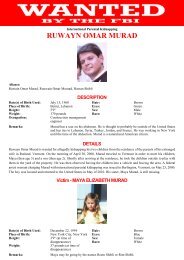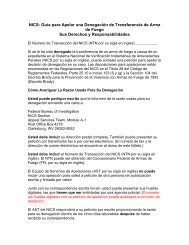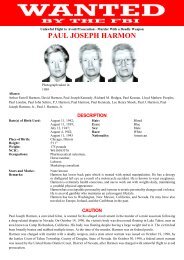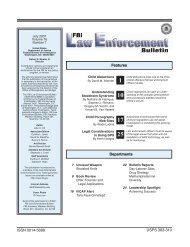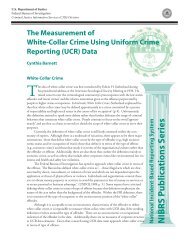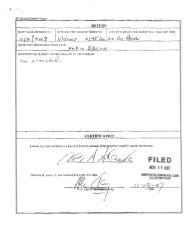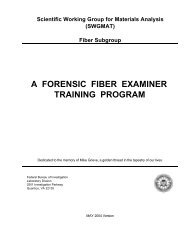F B I Law Enforcement Bulletin - June 2003 Issue
F B I Law Enforcement Bulletin - June 2003 Issue
F B I Law Enforcement Bulletin - June 2003 Issue
Create successful ePaper yourself
Turn your PDF publications into a flip-book with our unique Google optimized e-Paper software.
emphasize nonverbally, which can<br />
prove even more accurate and useful<br />
to investigators. People who<br />
typically use their hands while<br />
speaking punctuate their remarks<br />
with hand gestures that emphatically<br />
illustrate or exclaim. They<br />
also may thrust forward, point, or<br />
pound the desk as they emphasize.<br />
Others accentuate with the tips of<br />
their fingers, either touching things<br />
or gesturing with them. Hand<br />
behaviors compliment speech,<br />
thoughts, and true sentiments. 18<br />
Raising eyebrows (eyebrow flash)<br />
or widening eyes also emphasizes a<br />
point. 19<br />
When interested, people lean<br />
their torsos forward and, often, employ<br />
gravity-defying gestures, such<br />
as raising up on the balls of their<br />
feet as they make a significant or<br />
emotionally charged point. While<br />
sitting down, some emphasize by<br />
raising the knee to highlight important<br />
points. Occasionally, people<br />
will add emphasis by slapping their<br />
knee as it comes up, indicative of<br />
emotional exuberance. Gravity-defying<br />
gestures symbolize emphasis<br />
and true sentiment, both of which<br />
liars rarely possess.<br />
In contrast, people de-emphasize<br />
or show lack of commitment by<br />
speaking behind their hands or<br />
showing limited facial expression<br />
as if to control their countenance<br />
because they are not committed to<br />
what they are saying. 20 Deceptive<br />
people often show deliberative,<br />
pensive displays, such as touching<br />
fingers to their chin or stroking their<br />
cheeks, as though they still are<br />
thinking about something, rather<br />
than emphasizing the point they are<br />
making. They are evaluating what<br />
22 / FBI <strong>Law</strong> <strong>Enforcement</strong> <strong>Bulletin</strong><br />
they said and how it is being received,<br />
which is inconsistent with<br />
honest behavior.<br />
Synchrony<br />
In interviewing and detecting<br />
deception, synchrony plays an important<br />
role. Ideally, synchrony<br />
(e.g., harmony, congruence, and<br />
concordance) should occur between<br />
the interviewer and the interviewee;<br />
between what is said vocally and<br />
nonverbally; between the circumstances<br />
of the moment and what the<br />
subject is saying; and between<br />
events and emotions, including synchrony<br />
of time and space.<br />
In an interview setting, the tone<br />
of both parties should mirror each<br />
other over time if synchrony exists.<br />
21 A certain amount of harmony<br />
occurs in speech patterns, sitting<br />
styles, touching frequency, and general<br />
expressions. An interviewer<br />
and subject “out of sync” become<br />
subtly palpable because each will<br />
sit differently, talk in a manner<br />
or tone dissimilar from the other,<br />
and possibly have expressions at<br />
odds, if not totally disparate, with<br />
each other. These circumstances<br />
prohibit effective communication,<br />
an element pertinent to successful<br />
interviewing.<br />
When interviewed, people who<br />
answer in the affirmative should<br />
have congruent head movement<br />
supporting what they say. Lack of<br />
synchrony often occurs when<br />
people say, “I did not do it,” while<br />
nodding their heads up and down as<br />
if to say, “yes, I did.” Or, when<br />
asked, “Would you lie about this?”<br />
their heads again bob up and down.<br />
Upon catching themselves in this<br />
faux pas, they then reverse their<br />
head movement. When observed,<br />
these instances are almost comical<br />
and amateurish. More often, a mendacious<br />
statement, such as “I did<br />
not do it,” precedes a noticeably delayed<br />
and less emphatic negative<br />
head movement. These behaviors<br />
are not synchronous and, therefore,<br />
more likely to be equated with a lie.<br />
Synchrony should occur between<br />
what is being said and the<br />
events of the moment. During a<br />
street interview, if the subject interjects<br />
with superfluous information<br />
or facts totally irrelevant, the officer<br />
should note the disharmony. The<br />
information and facts should remain<br />
pertinent to the issue at hand,<br />
the circumstances, and the questions.<br />
When the answers are asynchronous<br />
with the event and questions,<br />
officers may assume that<br />
something likely is wrong or the<br />
person is stalling for time to fabricate<br />
a story.<br />
For instance, when parents report<br />
the alleged kidnapping of their<br />
infant, synchrony should occur between<br />
the event (kidnapping) and



